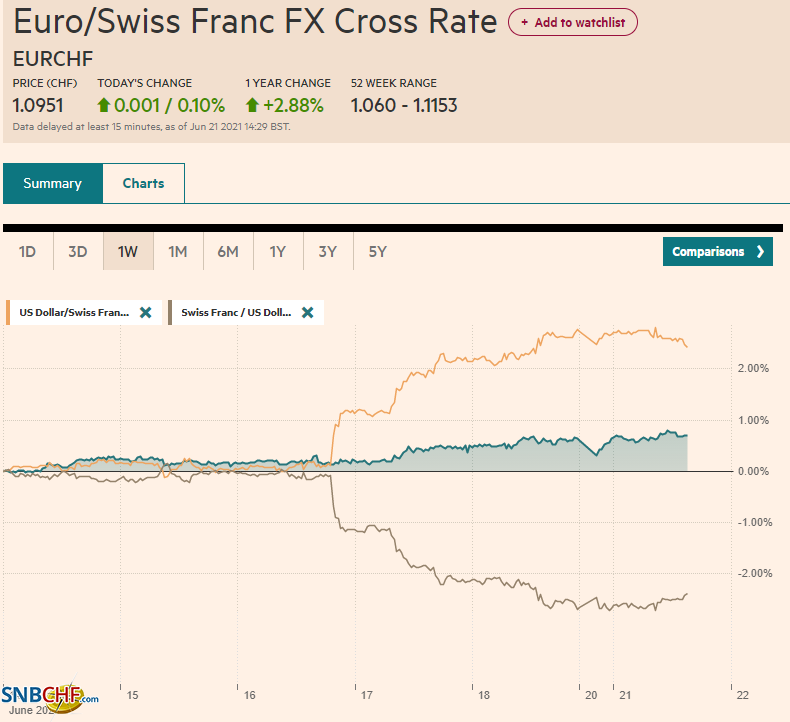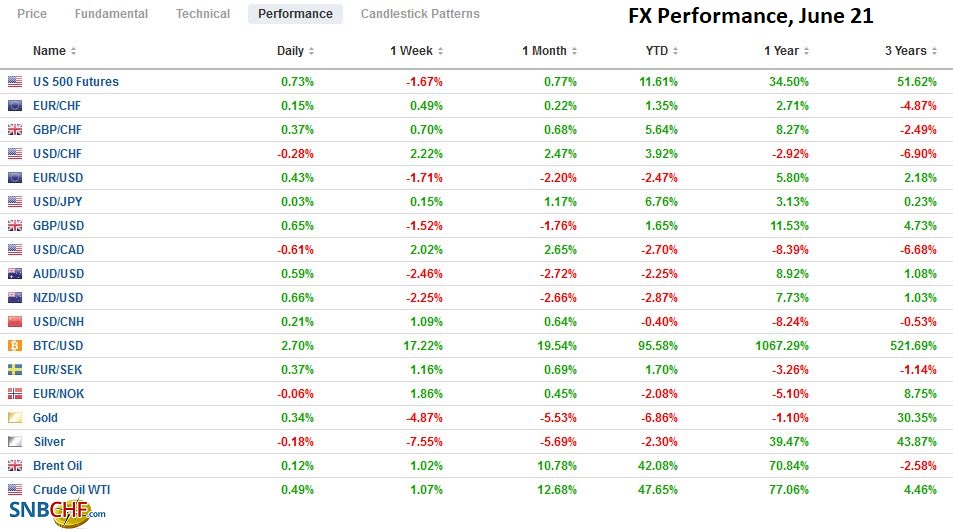Swiss FrancThe Euro has risen by 0.10% to 1.0951 |
EUR/CHF and USD/CHF, June 21(see more posts on EUR/CHF, USD/CHF, ) Source: markets.ft.com - Click to enlarge |
FX RatesOverview: Pressure on equities seen last week carried over into Asia and Europe today. The MSCI Asia Pacific Index fell for the fourth consecutive session, led by more than a 3% decline in the Nikkei. Australia, Taiwan, and Hong Kong bourses fell by more than 1%. European equities opened lower, but have turned higher. The Dow Jones Stoxx 600 is up about a third of a percent in late morning turnover. US futures have found some bids and are up around 0.5%. The US 10-year yield is soft at 1.43%. The 30-year yield, which initially pushed below 2.0% for the first time in six months, is now holding above it. European rates are narrowly mixed. The dollar, which rallied strongly in response to the FOMC, is softer to start the new week. Led by the Antipodeans, sterling, and the euro, the majors are mostly up around 0.2%-0.4% against the greenback. The Japanese yen and Swiss franc are the laggards rising less than 0.10%. Asian emerging market currencies and the Russian ruble are lower, while European currencies, the Mexican peso, and South African rand are posting modest gains. The JP Morgan Emerging Market Currency Index is trying to snap a six-day slide. Gold, too, is posting its first gain in seven sessions near $1785. Oil is firm, with the July WTI, around $72. Copper remains heavy after losing almost 8.5% last week. Steel rebar and iron ore fell in Shanghai earlier today. |
FX Performance, June 21 |
Asia Pacific
China kept its land prime rates steady at 3.85% and 4.65% for the 1-year and 5-year, respectively. It was not surprising, but with rising price pressures, it suggests that Beijing is not too concerned yet. While the PBOC is not providing much extra liquidity beyond what is needed to roll over loans, it is not tightening policy further. Separately, Taiwan has recalled seven of its representatives to Hong Kong in protest of the city’s officials pressing harder for all the representatives to take an oath recognizing one-China. This could spill over and impact trade relations.
South Korea continues to report strong trade figures, which are understood as further confirming regional and global recovery. Exports in the first 20 days of June rose 29.5% from a year ago, and when adjusted for the number of working days, it is closer to 34%. Exports to China, Seoul’s largest trading partner, rose 7.9%, while shipments to the US rose by more than 41%. Exports to Europe jumped about 48% and 33% to Japan. Exports of semiconductors increased by 28%. Auto shipments surged by more than 62%. Wireless communication product exports rose by a little more than 15%.
The dollar fell to a four-low against the yen near JPY109.60 before finding a solid bid that has pushed it back above JPY110.00, where a $1.2 bln option expires today. Another option at JPY110.50 that also expires today seems too far away. The JPY110.20-JPY110.30 area may be a sufficient cap.
Last week’s strong employment data has spurred some speculation that the Reserve Bank of Australia may adjust its QE and yield-curve control at next month’s meeting. The Aussie is snapping a four-day nearly 3% slide. To begin repairing the technical damage, it needs to re-establish a foothold above $0.7550. It is in about a quarter-cent range on either side of $0.7500 so far today.
The dollar gained on the Chinese yuan for the third consecutive session and the sixth in the past seven. It rose by around 0.25% to about CNY6.4685, a six-week high. We have suggested near-term potential toward CNY6.4700-CNY6.4950. The PBOC seems content, though. Today’s reference rate for the dollar was set at CNY6.4546 compared to the median bank model in Bloomberg’s survey for CNY6.4554.
Europe
Neither Macron’s En Marche party nor Le Pen’s National Rally party did well in the first round of France’s regional elections. The traditional center-right parties got around 29% of the vote, while the Left and Greens garnered around 34%. Le Pen received less than 20%, while Macron barely got more than 10%. The second round will be held next Sunday. Separately, polls in Germany show the CDU is extending its gain over the Greens to around 8 percentage points. A CDU would likely prefer a coalition with the FDP, but the Black-Green coalition is not as improbable as it appeared even a few years ago. Lastly, Sweden’s minority government lost a vote of confidence. The story is still unfolding, but Prime Minister Lofven has a week to call snap elections or allow the biggest parties to form a new government.
European-led efforts to get the US and Iran into compliance with the nuclear agreement have become more complicated by the elections that gave Raisi an easy victory. He is seen as a likely successor to Supreme Leader Khamenei. Raisi was sanctioned by the US in 2019. The sixth round of talks ended last week, and significant differences remain. One key issue that will likely be seen in other areas is that Iran wants a guarantee that the US will not unilaterally withdraw from any new agreement. The current president Rouhani, a moderate, remains in office for a little more than another month, but the window of opportunity seems small. A key consequence is that Iranian oil will likely stay off the market longer, which would seem to lend support to prices.
The euro held the pre-weekend low just below $1.1850 and is testing the $1.1900 in late European morning turnover. An option for 655 mln euros at $1.1900 expires today. Initial resistance is seen around $1.1925, the high before the weekend. Although last week’s drop seems exaggerated, a V-bottom does not seem the most likely scenario. Still, after last week’s slide, some backing and filling could see the euro edge close to $1.20 in the coming days.
Sterling’s losses were initially extended to a little below $1.3790 before it too found a bid. It has recovered to almost $1.3880. The $1.3900-$1.3950 area may cap near-term gains. The Bank of England meets on June 24, and it is expected to bide its time with the spreading contagion slowing the economy re-opening for another four weeks.
America
Leaving aside the Fed’s strategic ambiguity like how long transitory is supposed to refer to (see here) or what period of time is referred to in the average inflation rate target, there are two areas in which many market participants are confused. The first is the measure of inflation the Fed targets. Many wrongly understand it to be the core rate of the PCE deflator. Journalists do not help matters when they call it the “Fed’s preferred rate.” If it was “preferred,” why doesn’t the Fed target it. The Federal Reserve targets the headline PCE deflator.
The Fed has taken a step to fix a second area of communication misunderstanding. Many, including Fed officials themselves, often refer to the rate the Fed pays on bank balances kept at the Fed as interest on excess reserves (IOER), which is raised by five basis points to 15 bp last week. However, in fact, the Fed also pays interest on required reserves. Starting at the end of next month, the Fed will drop references to IOER and replace it with IORB, “interest on reserve balances.” The idea of paying interest on excess reserves is understandable. The introduction of quantitative easing, in which the Fed credits its counterparties with reserves in exchange for long-term assets (hence the idea of a swap). In order to provide incentives to keep the reserves with it, the Fed pays interest. However, some reserves are required for regulatory purposes. Many non-financial businesses and households keep a cash buffer (e.g., three months rent). Some argue that the interest on reserves (only since 2008 has the Fed been authorized to pay such interest) is to offset what amounts to a type of tax. But is this really true? Wouldn’t banks do what other businesses and households do? Maybe, for systemic reasons, banks’ reserves are more important, and ensuring some minimum level is important, yet why should they be paid to do the prudent thing when others aren’t?
Regional Fed presidents Bullard and Kaplan, seen among those favoring earlier rate hikes, speak today, but neither have FOMC votes this year. NY Fed President Williams, a permanent voter, also speaks and is more dovish. Five Fed officials maintained that a rate hike may not be necessary until after 2023. We imagine that the five include the Fed’s leadership, Powell, Quarles, and Clarida. That leaves two others, and Kashkari seems to be one, suggesting that either Williams or Brainard may be the other.
North America has a light economic calendar to start the week. The highlights are for the US, housing data, the preliminary PMI, trade, and the PI/PCE. Canada’s highlight is April retail sales in the middle of the week. Mexico will report April retail sales and biweekly inflation before the central bank meets on Thursday. Banxico is expected to stand pat but may sound a bit more hawkish. The market appears to be pricing in a little more than a 25 bp hike in H2.
The US dollar was squeezed higher against the Canadian dollar last week, rising 2.5% to cap the four-week advance. It ran out of steam near CAD1.2490 in Asia today, a marginal new high for the move, but has come back offered in the European morning. It is testing the CAD1.2425 area. Initial support is seen around CAD1.2400, and a break could see CAD1.2350.
Last week, the greenback rose almost 4% against the Mexican peso to rise to a three-month high near MXN20.75. It has eased to around MXN20.55 so far today. Support is seen closer to MXN20.40-MXN20.50, which houses the 200-day moving average.
Graphs and additional information on Swiss Franc by the snbchf team.
Full story here Are you the author? Previous post See more for Next postTags: #USD,China,Currency Movement,EUR/CHF,Featured,federal-reserve,France,newsletter,South Korea,Sweden,USD/CHF


























